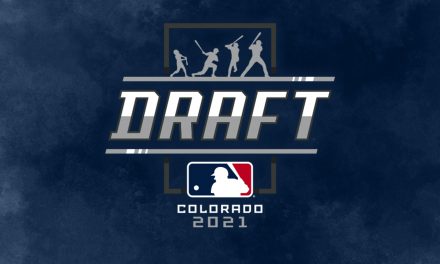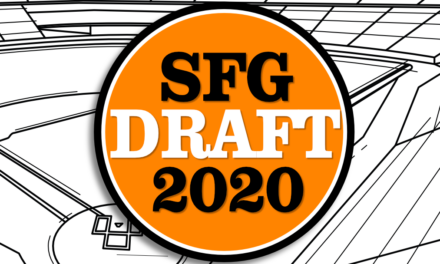On Day 2 of the 2021 Draft, the San Francisco Giants had nine picks, and used all but their last one on pitching.
In the third draft under President of Baseball Operations Farhan Zaidi, the Giants shook off past reputations of being interested in college hitting at the higher rankings, having drafted starting pitcher Will Bednar in the first round. But as each pick came across, the Giants took pitcher after pitcher, taking one of the franchise’s longest draft-opening streaks for pitching in its draft history. The team took an outfielder with their 10th round pick, the final pick of the day.
The Giants also leaned heavily on college players, with seven of the day’s nine picks coming from 4-year universities. Only 4th rounder Eric Silva, from JSerra Catholic High School, and 9th rounder Mat Olsen, from junior college Central Arizona College, were not from those schools.
The draft will continue on Tuesday, finished at 20 picks, the first year with the amount of picks. The 2020 draft was only five picks long, but before the pandemic, the drafts had been 40 rounds long.
Round 2 (50) – Matt Mikulski, LHP, Fordham
Rankings: MLB-50; Baseball America-40
Mikulski comes from the left side with an unorthodox delivery that can get up to the high-90s, but usually sits 92-95 when he works as a starter. He has both a slider and changeup which are average pitches, that work more on deception than motion. He also has a curveball that is more of a show-me pitch. He was the Atlantic-10 Pitcher of the Year, with a 1.45 ERA and struck out batters at a 16.3 K/9 rate. His unorthodox delivery and lack of polish with his command makes some think that he might be a reliever in the future, but he’s likely to start out in the rotation to see if he can make it work.
Round 3 (85) – Mason Black, RHP, Lehigh
Rankings: MLB-154; Baseball America-150
Late in the summer, Black’s rankings began to slide with a rough finish to the year. Black has a fastball that can reach up to triple-digits when he works out of relief, but when he starts, it’s more of a 94-95 mph pitch. He pairs it mainly with a slider that was very inconsistent at times, and an average changeup. Black was still making changes to his delivery this season, which led to his inconsistency, and some hope that with consistent coaches, his rough edges could be evened out. But with just three pitches, Black has a significant chance at becoming a reliever.
Round 4 (115) – Eric Silva, RHP, JSerra Catholic HS (CA)
Rankings: MLB-126; Baseball America-122
Silva’s best pitch this season was his fastball, which touched as high as 97 early in the season, but sat in the low-90’s later in the season. The change in velocity and his smaller stature, as a 6’1” pitcher, give some concern for his durability going forward, and has some believing the bullpen will be his future. He has a curveball that still needs to be defined better, as its shape can vary, and a changeup as well. Coming out of high school, there’s room for growth. He’s committed to UCLA, and will likely be expensive to sign.
Round 5 (146) – Rohan Handa, LHP, Yale
Rankings: MLB-NR; Baseball America-216
Handa had to find new ways to turn heads, since the Ivy League didn’t play in 2021, and so he played for the New England Collegiate League. His fastball grew from a mid-80’s pitch in 2020 to become a 97 mph fastball which he paired with a hard slider. He had a 1.06 ERA with 25 strikeouts and eight walks in five starts in the NECL (17.0 IP). He looks like a reliever in the pros, but may get chances as a starter
Round 6 (176) – Seth Lonsway, LHP, Ohio State
Rankings: MLB-153; Baseball America-139
Lonsway can be one of two pitchers depending on the day. Some days, he can look like a first round pick, others, he looks shaky and is unable to throw strikes. He has a mid-90’s fastball, but his best pitch is a big curve that draws comparisons to Barry Zito’s hook. He pairs it with a decent slider, and a show-me changeup. Lonsway struck out 13.0 K/9 at Ohio State, but also walked 5.7 BB/9, which is how his slid this far. With his control problems, he’s likely to head towards the bullpen.
Round 7 (206) – Nick Sinacola, RHP, University of Maine
Rankings: MLB-NR; Baseball America-346
The America East Pitcher of the Year had one of the best strikeout rates with a 15.8 K/9, and just 2.6 BB/9, but was more of a pitchability pitcher than having pure stuff. His fastball sits around 90 MPH, but he lives more on his slower slider, that sits between 72-84 MPH. He also has a splitter he can use with those pitches. With three pitches, he may move to relief
Round 8 (236) – Ian Villers, RHP, California
Rankings: MLB-NR; Baseball America-170
Villers spent three seasons at Cal pitching out of the bullpen, and sat in the mid-90’s that could hit 96-97, which he pairs with an average slider. With that velocity and a 6’6” frame, he can cut an imposing frame on the mound to hitters, and he has a changeup and curveball that aren’t yet part of his arsenal. He looks like he’s got a future in the bullpen as a pro as well.
Round 9 (266) – Mat Olsen, RHP, Central Arizona College JC
Rankings: MLB-NR; Baseball America-312
Olsen was one of the Junior College pitchers who stuck around for a third season after the pandemic gave them an extra year of an eligibility there. Olsen had a 2.13 ERA with 133 strikeouts in 88.2 innings, with a low-90’s fastball and a good curveball. He’s committed to Arizona State, but is considered very signable. He was the PItcher of the Year among Arizona junior colleges.
Round 10 (296) – Vaun Brown, OF, Florida Southern
Rankings: MLB-NR; Baseball America-NR
Brown took advantage of an extra year of eligibility after the pandemic. In his 5th year at Florida Southern, Brown hit .387/.462/.793 in 26 games in his senior season, with 13 home runs and six doubles. That was a huge improvement for him, as he’d hit in the high .200’s in his previous four seasons, but steadily improving his average each season.







Recent Comments